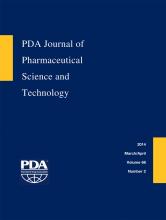Research ArticleTechnology/Application
Use of a Real-Time Microbial Air Sampler for Operational Cleanroom Monitoring
T. Eaton, C. Wardle and W. Whyte
PDA Journal of Pharmaceutical Science and Technology March 2014, 68 (2) 172-184; DOI: https://doi.org/10.5731/pdajpst.2014.00952
T. Eaton
1Sterile Manufacturing Specialist, AstraZeneca, Macclesfield, UK;
C. Wardle
2Technical Officer, Microbiology Laboratory, AstraZeneca, Macclesfield, UK; and
W. Whyte
3Honorary Research Fellow, University of Glasgow, Glasgow, UK

References
- 1.↵
- Sandle T.
- 2.↵
- Eaton T.,
- Davenport C.,
- Whyte W.
- 3.↵
- Bjerner G.,
- Kene V.,
- Åkerlund E,
- Andersson K.
- 4.↵
- Hinds W. C.
- 5.↵
- Molendhauer J.
- Niccum D.,
- Hairston P.
- 6.↵
BioTrak® real-time viable particle counter prevalidation test report. January 2013. TSI reference 5001493A.
- 7.↵
European Commission Guide to Good Manufacturing Practice, Annex 1: 2008; European Commission, Enterprise Directorate-General: Brussels, 2008.
- 8.↵
- Andersen A. A.
- 9.↵
- Kethley T. W.,
- Cown W. B.,
- Fincher E. L.
- 10.↵
- Ljungqvist B.,
- Reinmüller B.
- 11.↵
- 12.↵
Health Protection Agency. Physical Efficiency Testing of the Air Trace Environmental Slit to Agar Impaction Sampler. Health Protection Agency (Porton Down) Report 843/0, 10.03.04; Porton Down: Wiltshire, UK.
- 13.↵
ISO/FDIS 14698-1(2003). Cleanroom and associated controlled environments – Biocontamination control. Part 1: General principles and methods Annex B (informative) Guidance on validating air samplers, 2003.
- 14.↵
- Whyte W.,
- Green G.,
- Albisu A.
- 15.↵
- Morgan S. L.,
- Hall S. H.,
- Hendrix J. E.,
- Bartick E. G.
- 16.↵
- Whyte W.,
- Hejab M.
- 17.↵
- 18.↵
- 19.↵
- Lundholm I. M.
- 20.↵
In This Issue
PDA Journal of Pharmaceutical Science and Technology
Vol. 68, Issue 2
March/April 2014
Use of a Real-Time Microbial Air Sampler for Operational Cleanroom Monitoring
T. Eaton, C. Wardle, W. Whyte
PDA Journal of Pharmaceutical Science and Technology Mar 2014, 68 (2) 172-184; DOI: 10.5731/pdajpst.2014.00952
Jump to section
Related Articles
- No related articles found.





